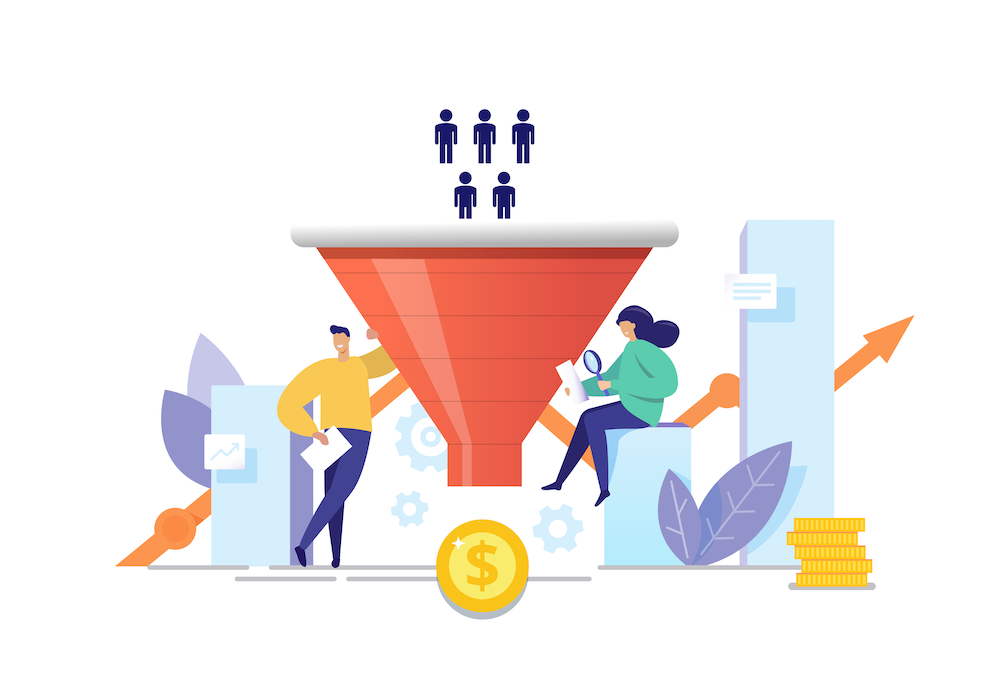Mastering the sales funnel is integral for any B2B organization. But the B2B buyer landscape is changing, and closing leads is becoming harder, with less than half of forecasted B2B sales being successfully closed. The B2B sales funnel must not only adapt to the new digital age, but to a new buyer with new ‘pull’ triggers. Here are four crucial steps PR and marketing pros can take to help optimize the B2B sales funnel and facilitate seamless sale journeys.
The traditional B2B buyer journey through the sales funnel is no longer sufficient. One of the main reasons for missed leads is due to a new younger generation of B2B buyers with new pull factors. Research from Gartner has found that in many B2B businesses, between 6 and 10 people with different self-interests will be involved in influencing the B2B buying process, including external stakeholders. In today’s digital era, 67% of B2B buyers prefer their primary source of information not to be from a sales representative, but from information they have gained themselves.
So how can organizations deliver a sales journey that meets these new expectations?
First, it’s about understanding that the sales funnel starts at the very top and goes all the way down to the bottom. It’s about optimizing and facilitating the way prospects and leads interact with a B2B organization online during the buying journey. Think: content marketing, account-based marketing (ABM) strategies, and aligning digital PR and marketing goals once and for all.
Here are four ways to optimize the B2B sales funnel and create more seamless customer journeys.
1. Lead identification calls for an all-out cross-media strategy.
At the very top of the funnel, where prospects become aware of a business, the focus must be on all fronts—social media, content marketing and SEO.
Research has shown that 80% of business decision-makers prefer to get company information from a series of articles versus an advertisement before making a decision, with 9 in 10 B2B buyers saying online content has a moderate to major effect on purchasing decisions. But how can B2B businesses find out what their leads are looking for and what industry struggles they are having?
Enter social listening a relatively new skill in B2B PR and marketing pros’ arsenal. Through its process of monitoring and analyzing social media conversations, PR and marketing pros can gain insights into industry pain points, market trends and brand narratives. From this, PR and marketing professionals can plan content tailored to the insights they’ve gained.
A good place to start is with a case study demonstrating how a company has helped overcome similar situations in their specific industry. To support this, social posts should be tailored with content and messaging that aligns with key industries that leads are in. Credibility and trust can be built through these techniques of consistent messaging with leads across multiple sources of content.
But all this work will be for nothing without good technical SEO. There is no point in having informative assets if prospective leads cannot find or navigate a company’s website. Technical SEO focuses on the user experience. Think: speed of website, mobile-friendly and ease of use. Why is this so important? This can be the make-or-break point of the B2B sales funnel; if the website is not accessible or user-friendly, this can cause businesses to lose the lead.
2.Make your business stand out—it’s time to showcase brand equity as leads enter the consideration stage.
Once prospects are aware of the business offerings, the pressure is on to show why it is the best in the market. How? Prospects want to know that a business understands their pain points, but they also want to know that they can help alleviate these ongoing issues.
It’s all about demonstrating expertise and establishing the company as a thought leader. Remember the power of executive profiling. Even though it’s business-to-business and buyers are choosing digital sources of information over human lead sales interactions, human relationships still matter. It’s time to establish executives as industry thought leaders and produce strong thought leadership content relevant to the pain points that leads are suffering.
In this way, businesses can address a lead’s specific concerns and showcase unique value proposition, because over 60% of B2B buyers cannot tell the difference between one B2B brand’s digital experience from another. It’s called showing off your brand equity—and at the same time making brand equity relatable to build trust in the minds of prospective leads.
And what’s not working is just as important as what is. Tracking lead-gen interactions through targeted backlinks, measuring social click-through, and analyzing web traffic and behavior on owned sites can identify where the buyer journey might be stumbling. For example, placed content may be generating a ton of click-throughs—but if the website can’t convert then there’s something missing somewhere. Adjust accordingly to unjam the sticking points for prospective B2B buyers.
3. Get personal with account-based marketing to target valuable leads.
But the journey doesn’t end here. In today’s information-driven world, people expect timely and relevant content promptly that can help address their pain points and guide them through the decision-making process. This is where a well-thought-out ABM strategy can prove its worth.
An ABM strategy will rely on analysis to identify target accounts and the correct contacts to reach out to. All data should also be shared between marketing, sales and PR teams to ensure activities are aligned with the correct information to guarantee a seamless buying experience and a smooth transition through the sales funnel.
Then it’s a case of creating targeted content aimed at just a handful of buying personas, delivered strategically across the channels they use. LinkedIn feeds, specific interest groups, the industry publications they read, targeted web ads and keywords—they can all converge to target a single prospect as many times as possible.
Influencer marketing and executive profiling may be fairly new practices in the B2B space, but they are both key parts of any B2B ABM strategy. In light of over a third of respondents to a B2B Influencer Marketing Research report claiming that influencer marketing can directly contribute to sales and revenue, it is a key tactic for PR and marketing professionals to use. Add executive profiling into the mix and B2B organizations can drive credible thought leadership, loyalty and brand awareness.
4. The last stage: Take a page from the B2C rulebook.
The last stage of the B2B sales funnel is one of the most important parts: Closing a deal can be difficult, and being at this stage doesn’t mean it’s a done deal. Nurtured leads pay off as they can generate 47% of larger purchases at a 33% lower cost.
This is not the end state for dealing with the B2B buyer, however. It is rather the start of a relationship. To make it an easy decision for the buyer, learn from B2C sales strategies and tactics by utilizing incentives and trial periods to encourage repeat business.
Case studies play a huge role in building trust and credibility. Permission to use the case study in the media might be a problem, but customers are often happy to be a sales reference, particularly if incentivized in some way. Real-life success stories of how a company overcame a specific industry problem or achieved exceptional results could just be the tipping point for a buyer to close a decision.
Nurtured leads will come to fruition at this stage—and then it’s all about the relationships that can be created and fostered through a positive customer experience to gain customer loyalty and encourage repeat business.
Moving through the sales funnel takes time—but it’s worth the wait.
The new era of B2B buyers and the amount of information and data available to them in today’s digital age means the B2B sales funnel is very time- and resource-intensive. By taking an aligned approach with other departments, PR and marketing professionals play a key role in turning leads into customers. With strategic content marketing and a personalized ABM strategy for each stage of the sales funnel, PR and marketing professionals can pull off a successful sale.
Georgia Harris is PR Lead Themes at IBA International.




